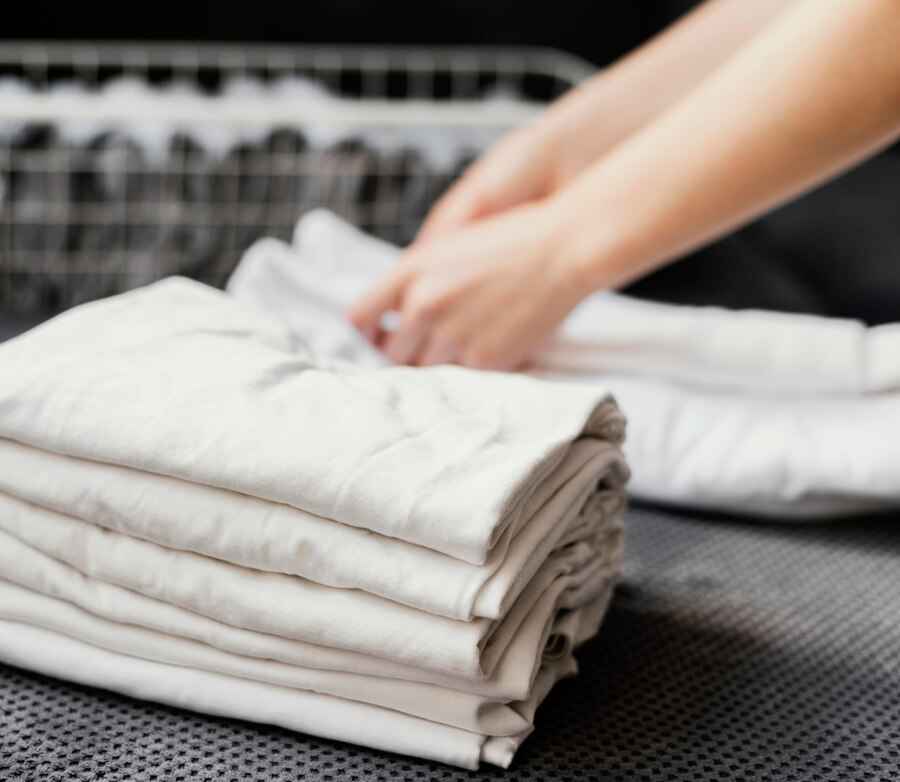Wool blankets are beloved for their warmth, softness, and durability. However, many people feel intimidated by the thought of washing them. Unlike synthetic fabrics, wool requires special care to maintain its quality. But don’t worry—washing a wool blanket can be simple if you follow the right steps. Let’s walk through how you can clean your wool blanket without shrinking or damaging it, ensuring it stays as cozy and soft as the day you bought it.
Understanding Your Wool Blanket
Before you even think about washing your wool blanket, it’s essential to understand the type of wool and the specific care instructions. Different types of wool—like Merino, Cashmere, or Alpaca—may have varying care needs. Always check the care label on your blanket first.
Mary Marlowe Leverette, a Home Cleaning Expert, emphasizes, “Wool blankets require special care to maintain their softness and shape. Always check the care label for specific instructions.” These labels are more than just suggestions—they help you avoid common mistakes that could damage your blanket.
Why Wool Needs Special Care
Wool is a natural fiber that has unique properties. It’s breathable, moisture-wicking, and insulating, making it perfect for blankets. However, wool fibers can shrink or become misshapen when exposed to high temperatures or agitation. This is why you can’t just throw a wool blanket in the washing machine like you would with cotton or synthetic materials.
Rachel Hoffman, a Carpet Cleaning Expert, advises, “Hand washing is often the safest method for cleaning wool blankets. Use a gentle detergent and lukewarm water.”
How to Hand Wash a Wool Blanket
Hand washing is the most recommended method for cleaning wool blankets because it allows you to control the temperature and movement, reducing the risk of shrinkage or damage.
Materials You’ll Need:
- A clean bathtub or large basin
- Mild wool detergent (avoid regular laundry detergent)
- Lukewarm water (around 85°F or 30°C)
- Clean towels for drying
Steps:
- Prepare the Wash Area: Fill your bathtub or basin with lukewarm water and add the wool detergent, mixing it until it’s fully dissolved.
- Submerge the Blanket: Gently place the wool blanket in the water. Swirl it around with your hands to help the detergent penetrate the fibers. Avoid scrubbing or wringing the blanket, as this can damage the wool.
- Soak: Let the blanket soak for about 10-15 minutes. This will allow the detergent to clean the fibers without excessive agitation.
- Rinse: Drain the soapy water and refill the tub with fresh, lukewarm water. Swirl the blanket around again to rinse out the detergent. You may need to repeat this step a couple of times to ensure all the soap is removed.
- Remove Excess Water: Once rinsed, carefully lift the blanket out of the water. Avoid twisting or wringing it out. Instead, press it gently against the side of the tub to remove excess water.
Becky Rapinchuk, a Cleaning Expert, suggests, “If hand washing is not feasible, look for a commercial laundry service that specializes in wool or delicate fabrics.”
Drying Your Wool Blanket
Drying is just as crucial as washing when it comes to wool care. Wool blankets should never be tossed into a dryer, as the heat can cause shrinkage and damage the fibers.
The Spruce advises, “Air drying is the preferred method for drying a wool blanket. Avoid using a dryer, as the heat can damage the fibers.”
Steps:
- Lay the Blanket Flat: Spread a clean, absorbent towel on a flat surface. Lay the wool blanket on top of the towel, ensuring it’s flat and not bunched up.
- Roll It Up: Starting from one end, gently roll the towel and blanket together, pressing as you go to absorb excess water. This helps to remove water without distorting the blanket’s shape.
- Air Dry: Unroll the blanket and lay it flat on a dry towel or drying rack. Make sure it’s in a well-ventilated area but out of direct sunlight, which can fade the colors and weaken the fibers.
Good Housekeeping recommends, “To prevent shrinkage, lay the wet blanket flat to dry on a clean, absorbent towel.”
Personal Anecdote: I learned this the hard way once when I tried drying my wool blanket on a line outside. The sun faded it, and it lost that soft, cozy feel. Now, I always dry it flat indoors, and it stays in perfect condition.
Can You Machine Wash a Wool Blanket?
While hand washing is the safest option, some wool blankets can be machine washed, provided the care label says it’s safe to do so. However, you’ll need to take special precautions.
Steps:
- Use the Gentle Cycle: Set your washing machine to the delicate or wool cycle. This setting uses less agitation, reducing the risk of damage.
- Cold Water Only: Always use cold water when machine washing wool. Warm or hot water can cause the wool to shrink.
- Mild Detergent: Use a wool-specific detergent. Regular detergents are too harsh and can strip the natural oils from the wool, making it feel rough.
- Skip the Spin Cycle: If possible, skip the spin cycle or set it to the lowest setting. High spin speeds can cause the wool to stretch or lose its shape.
Even with these precautions, machine washing still carries a risk. The Wool Products Labeling Act ensures that wool products come with specific care instructions, but following them is crucial to maintaining the integrity of your blanket.
Storing Your Wool Blanket
Proper storage is key to extending the life of your wool blanket. When you’re not using it, make sure it’s clean and completely dry before putting it away.
Steps:
- Fold Neatly: Fold your blanket neatly to avoid creases that can stretch out the fabric.
- Use a Breathable Storage Bag: Store the blanket in a breathable cotton or linen bag. Avoid plastic bags, as they can trap moisture and lead to mildew.
- Avoid Direct Contact with Wood: If you’re storing the blanket in a wooden chest or drawer, line the storage area with acid-free tissue paper to prevent the wool from absorbing any oils or stains from the wood.
Personal Anecdote: One winter, I made the mistake of storing my wool blanket in a plastic bag. When I took it out the next season, it had a musty smell, and the fibers felt damp. I learned my lesson and now always use a cotton bag for storage.
Dealing with Stains on Wool Blankets
Accidents happen, and sometimes your wool blanket might end up with a stain. The key is to treat stains as soon as possible before they set in.
Steps:
- Blot, Don’t Rub: If you spill something on your blanket, gently blot the stain with a clean cloth. Rubbing can push the stain deeper into the fibers.
- Spot Clean: Mix a small amount of wool detergent with lukewarm water and gently dab the stained area with a cloth. Rinse with clean water and blot dry.
- Air Dry: Allow the treated area to air dry completely before using or storing the blanket.
For tough stains, it might be worth consulting a professional cleaner who specializes in wool. Dry Cleaning Services can offer advice and methods for treating difficult stains without damaging your blanket.
Final Thoughts: Caring for Your Wool Blanket
Washing and caring for a wool blanket may require a little extra effort, but it’s well worth it to keep your blanket soft, cozy, and in great condition. By hand washing with gentle detergent, air drying, and storing it properly, you can ensure that your wool blanket remains a beloved part of your home for years to come.
As Becky Rapinchuk says, “If hand washing is not feasible, look for a commercial laundry service that specializes in wool or delicate fabrics.” With the right care, your wool blanket will continue to provide warmth and comfort for many winters ahead.
So next time you cozy up with your favorite wool blanket, you can do so with the confidence that you know how to keep it looking and feeling its best. Whether it’s a cherished family heirloom or a new purchase, your wool blanket deserves the best care you can give.
Washing and Caring for a Wool Blanket: At a Glance
| Step | What to Do | Why It Matters |
|---|---|---|
| Check the Care Label | Read the care instructions on your wool blanket | Different types of wool may have specific care needs |
| Hand Wash | Use lukewarm water and mild wool detergent | Prevents shrinkage and damage to delicate wool fibers |
| Rinse Thoroughly | Rinse with clean, lukewarm water to remove all detergent | Ensures no soap residue is left behind |
| Remove Excess Water | Press gently against the tub or roll in a towel to absorb water | Avoids stretching or distorting the blanket’s shape |
| Air Dry Flat | Lay the blanket flat on a towel or drying rack in a well-ventilated area | Prevents shrinkage and maintains the blanket’s softness |
| Machine Wash (Optional) | Use the delicate cycle, cold water, and wool detergent (if label allows) | A safer alternative to hand washing if done correctly |
| Store Properly | Fold neatly and store in a breathable cotton or linen bag | Protects the blanket from moisture, mildew, and pests |
| Treat Stains | Blot stains gently and spot clean with wool detergent | Prevents stains from setting in and damaging the fibers |
Quick Tips for Wool Blanket Care
- Always Check the Label: Follow the manufacturer’s care instructions to avoid damage.
- Use Lukewarm Water: Hot water can shrink wool, so stick to lukewarm temperatures.
- Avoid Agitation: Gently swirl or press the blanket—never scrub or wring it out.
- Dry Flat: Air drying flat prevents stretching and maintains the blanket’s shape.
- Store Smart: Use breathable storage bags and avoid plastic to prevent mildew.
Common Mistakes to Avoid
| Mistake | Why It’s Bad | What to Do Instead |
|---|---|---|
| Using Hot Water | Causes wool fibers to shrink and lose softness | Stick to lukewarm or cold water |
| Wringing or Scrubbing | Damages the fibers and distorts the blanket’s shape | Gently press or roll to remove water |
| Drying in Direct Sunlight | Fades colors and weakens fibers | Dry in a shaded, well-ventilated area |
| Storing in Plastic Bags | Traps moisture, leading to mildew and musty smells | Use breathable cotton or linen storage bags |










